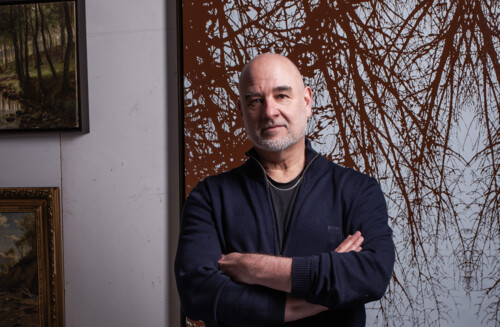Landscape Engineering - Sven Drühl
Images of the Exhibition
Description
Galerie Wolfgang Jahn presents its first solo exhibition of works by Sven Drühl in its gallery with the "Landscape Engineering" exhibition. Born in 1968 in Nassau an der Lahn, Drühl is a visual artist living in Berlin and also holds a doctorate in art theory and a degree in mathematics. This expertise is crucial to a full understanding of his artistic work.
High mountain peaks covered in snowfields, whose uniformly dark, rough, jagged masses of rock stand out in stark contrast in the form of ridges, flanks, rocky outcrops and glacial moraines. Seascapes that capture the play of the moving surface of the water, with its crests and troughs of the waves, in a graphic network of lines in the light elevations and dark depressions of its folds. Tree structures shaded in black, whose many branches stand out in the twilight against a grey, cloudy sky like veins and synapses. Drühl confronts, seduces and inspires the viewer with landscapes of the highest artistic precision, without wanting to conform to the genre in the conventional sense. A closer and more analytical look at his work, the way he works and the techniques he uses to create his images resolve this apparent contradiction. The concept of "resolution", with its associations with computer-based images and detailed screen reproductions, as well as abstraction in the sense of breaking down content into elements of colour and form is a key factor in understanding his work.
Drühl's mountain panoramas seem strangely familiar and yet they are not. At first glance, you think you can make out striking peaks and mountain ranges and associate them with alpine hotspots for mountaineering, only to realise on closer inspection that something is not quite right and that it is an illusion. The convincing use of light and shadow inherent in the image is also misleading and deviates from the laws of reality when compared to the photographic images of well-known mountain peaks. Drühl is not a classic landscape painter who takes nature as his direct model. His mountains are products of the imagination, composed of various set pieces of reality until they become purely fantastic formations. His motifs are computer-generated views, developed with the help of artificial intelligence from the vast pool of images on the Internet. Here the artist shows his influence in the spirit of appropriation art by using found and selected sources. In his case, these are vector graphics, digital files that can be scaled and edited in any way you like. He obtains this data from specialist suppliers to game development studios, who provide the detailed backgrounds in elaborate computer games, for example, in order to best guarantee the phenomenon of "immersion", the feeling of being completely immersed in an illusory space. The motif is created on Drühl's computer by selecting a suitable section. The template created in this way is then realised in a technically complex process as a stencil that defines the shapes and contours. This is plotted out as an adhesive film and applied to the canvas, which has been pre-treated with layers of paint. The next step is to apply paint and varnish to colour the individual punched-out areas, before removing the stencil piece by piece. Contrary to expectation, the white of the snow cover is not the final layer, but shines out from the background of the first layers of paint. The sometimes glossy layers of paint, which make the rock formations appear homogeneous and smooth, are also irritating in that they actually contradict the rough structure of their material composition.
Drühl's complex working method can be described as a process of analysis and synthesis. He deconstructs the original into individual abstract patterns and shapes and structurally reassembles the overall picture from these individual formal elements, which appear like patches of colour, to form his all-encompassing pictorial structure. Despite this precise and increasingly complex differentiation of form, the overall impression of his paintings remains one of graphic reduction, evocative of the printing process, especially given the stark contrasts between light and dark.
Drühl's works appear cool and distant, strangely alienated and as if through a filter, not least because they do not feature humans or any trace of them. In his mountain paintings, the artist consciously and resolutely resists the appropriation of them as "landscapes of meaning", which has long characterised the tradition of landscape painting in past centuries. As a result, his depiction of the mountain ranges may be imposing, but it does not appear to be charged with a pathetic or heroic quality. As virtual objects with a distant relationship to reality, they also do not allow for any identity-forming romanticisation of the homeland. Drühl frees the mountains from the imposed ballast of their interpretation in the past. And yet his paintings leave enough room for emotion. Looking at his works, a feeling of melancholy and loneliness may creep up on you, feelings that are not confined to the frozen peaks but can also be felt in the virtual world masquerading as reality to us, in which the individual can get lost as a mere avatar. Sven Drühl's aesthetic, sometimes superficially decorative images become multi-layered conceptual art.
Dr. Veit Ziegelmaier






